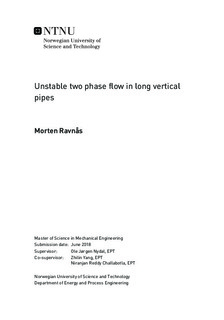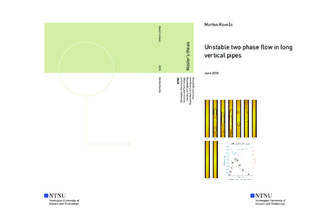| dc.description.abstract | Flow instabilities can cause operational problems when transporting multiphase mixtures of oil and gas in offshore risers and pipelines. Several types of flow instabilities have been studied and are well documented. This study will focus on Expansion Driven flow Instability (EDI) phenomena, which is relatively little known and hence this type of flow dynamic needs to be demonstrated and documented better. EDI is a phenomena where instabilities are induced by gas expansion in the riser itself. Small amount of accumulated trapped gas upstream the riser base could cause instabilities and cyclic behaviour when entering the riser due to the expansion driven flow acceleration given to the liquid column.
The purpose of this master thesis is to demonstrate and document EDI phenomena, through experiments and computational flow simulators. The experiments are conducted in the multiphase lab at the Norwegian University of Science and Technology (NTNU), where a new experimental test facility for long vertical pipes is installed. Experimental results are thereafter compared with simulation results from dynamic multiphase flow simulators (OLGA and Sluggit).
Experiments are conducted for five different centrifugal pump frequencies, which is simulating a typical reservoir source at varying conditions. The fluids which are tested is air and water at atmospheric conditions. Air is injected into the system with constant flow rates, located upstream the riser base. For entrapment of air in the horizontal test-section a geometrical bump (jumper) is installed. The vertical pipe is 17,28m with a pipe inner diameter of 0,06m. To capture the EDI phenomena, pictures and videos are recorded using cameras, and data logged using pressure sensors and flow meters.
Oscillating behaviour are present for the three lowest pump frequencies, while the two remaining shows stable flow regime for all air flow rates injected. The trend is stable flow regime for high pump frequencies and high air flow rates.
OLGA is one of the multiphase flow simulator used during the study to verify the experiments. The numerical model is able to reproduce results which is close to some of the results observed in the experiment, with maximum 12\% error, calculating the mean values. However, discrepancies are observed regarding the stability limits. These discrepancies may be attributed from geometrical simplifications and assumptions conducted in the model.
A 1D two-fluid model in the multiphase flow simulator Sluggit is developed. This model failed to capture the oscillation/instabilities observed for low injected air flow rates in the experiment. The Sluggit model showed on the other hand good agreement with the observed experimental results, in stable flow conditions.
An extension to the main experiment is conducted to map the flow patterns for higher air flow rates. Slug flow is observed for the highest superficial gas velocity (6,6m/s) tested.
Both experimental results and OLGA simulations demonstrated that Expansion Driven flow Instability phenomena occurs in the tested lab setup. | |

